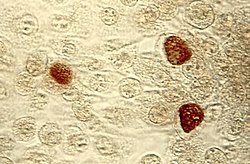| PVC | |
|---|---|
 | |
| Chlamydia trachomatis | |
| Scientific classification | |
| Domain: | Bacteria |
| Kingdom: | Pseudomonadati |
| Superphylum: | "PVC" |
| Phyla | |
| Synonyms | |
Planctobacteria Cavalier-Smith, 1987 [1] | |
The PVC is a superphylum of bacteria named after its three important members, Planctomycetota, Verrucomicrobiota, and Chlamydiota. [2] [3] Cavalier-Smith postulated that the PVC bacteria probably lost or reduced their peptidoglycan cell wall twice. [4] It has been hypothesised that a member of the PVC clade might have been the host cell in the endosymbiotic event that gave rise to the first proto-eukaryotic cell. [5] [6]
Cavalier-Smith calls the same group Planctobacteria and considers it a phylum. However, this is not followed by the larger scientific community. [7] In the Cavalier-Smith bacterial megaclassification, it is within the bacterial Gracilicutes infra-kingdom and comprises the phyla Chlamydiota, Lentisphaerota, Planctomycetota, Verrucomicrobiota. [4] [8]
| PVC superphylum [9] [10] [2] [11] |